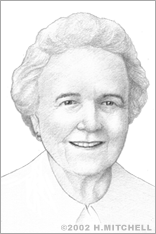Ruth Patrick
Limnologist Ruth Patrick was born in Topeka, Kansas on November 26, 1907. As a child she learned to appreciate nature, especially plants, after numerous trips to the countryside with her family. Later she developed an interest in the microscopic organisms in water. In 1929, she received her BS degree from Coker College in South Carolina. She received her MS degree from the University of Virginia two years later.
Patrick served as a research assistant at Coker College and Temple University before returning to Virginia to earn her PhD in Botany in 1934. She went on to become an assistant curator at the Academy of Natural Sciences in Philadelphia before being promoted to chair of the Limnology Department and curator of Limnology.
Patrick is well-known as a biologist responsible for raising ecological awareness in our society. Her efforts in the field of limnology, the study of freshwater ecosystems, led to the methods by which the environmental health of rivers and streams is evaluated today. Her particular expertise is diatoms, single-celled algae that are a basic food source for organisms living in fresh water. In order to accurately determine the presence of pollution in fresh water, Patrick invented the diatometer, a device that accurately determines the presence of pollution in fresh water.
In the early 1950s, Patrick was assigned by the Atomic Energy Commission to collect baseline data on the water quality of the Savannah River, prior to the opening of the Savannah River Plant. With a team of scientists from the Philadelphia Academy of Sciences, she was the first to diagnose the health of a river or stream by analyzing plant life and animal species. Her early studies contributed significantly to the developing field of ecology, and established for the first time a set of aquatic indices that could be used to describe the health of water systems and the impact of industrialization. Ecologists worldwide have modeled her work.
Patrick was the first woman elected chair of the board of the Academy of Natural Sciences. She taught limnology and botany at the University of Pennsylvania for more than thirty-five years and wrote a number of books on the environment, including “Rivers of the United States,” “Power So Great,” and “Colors of Tomorrow.” She was a member of President Johnson's Science Advisory Committee on Algeal Blooms in 1966; she was chairman of the Panel of Pollution Control of the National Academy of Sciences from 1973-75; and she was a member of President Reagan's Peer Review Committee on Acid Rain.
Patrick was awarded the National Medal of Science by President Clinton, the Eminent Ecologist Award from the Ecological Society of America, and 25 honorary degrees. The University of South Carolina's Ruth Patrick Science Education Center is also named in her honor.
Patrick passed away on September 23, 2013, in Lafayette Hill, PA. She was 105 years old.


